ITC556 Assignment 3: Database Normalization to 3NF and ER Diagram
VerifiedAdded on 2024/07/01
|11
|700
|500
Homework Assignment
AI Summary
This document presents a solution to a database normalization assignment, detailing the process of transforming a database through First Normal Form (1NF), Second Normal Form (2NF), and Third Normal Form (3NF). It includes a dependency diagram illustrating functional, partial, and transitive dependencies. The solution provides relational schema demonstrating relationships between tables (Meeting, Event, and Person) and an Entity Relationship Diagram (ERD) for a graphical representation of the database structure. The purpose of this normalization is to eliminate data redundancy and improve data integrity. Desklib offers a variety of similar solved assignments and past papers to aid students in their studies.

ITC 556
Assessment item 3
Normalization
Student Name – Murali Krishna Palle
Student ID- 11593385
Table of Contents
Assessment item 3
Normalization
Student Name – Murali Krishna Palle
Student ID- 11593385
Table of Contents
Paraphrase This Document
Need a fresh take? Get an instant paraphrase of this document with our AI Paraphraser
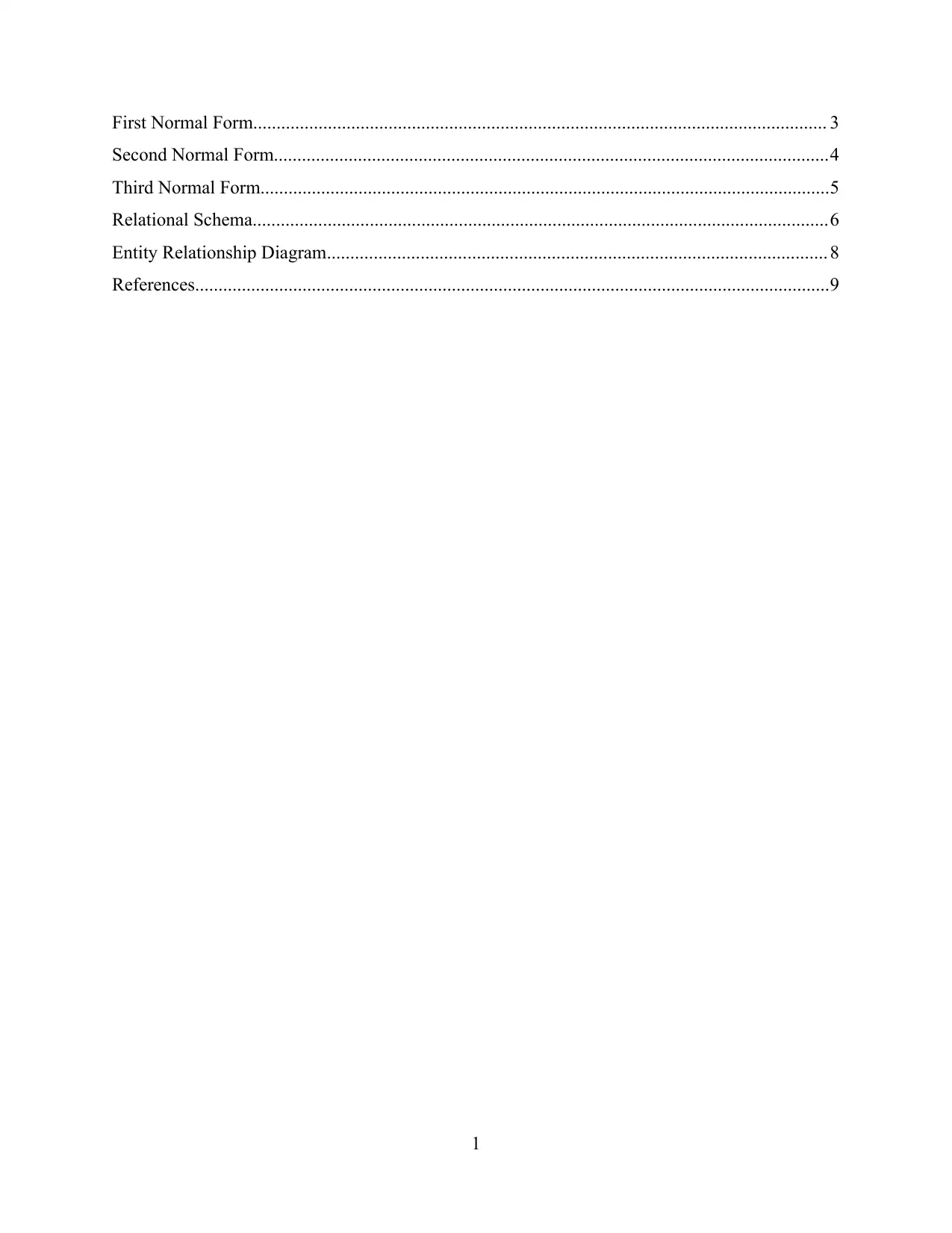
First Normal Form........................................................................................................................... 3
Second Normal Form.......................................................................................................................4
Third Normal Form..........................................................................................................................5
Relational Schema...........................................................................................................................6
Entity Relationship Diagram........................................................................................................... 8
References........................................................................................................................................9
1
Second Normal Form.......................................................................................................................4
Third Normal Form..........................................................................................................................5
Relational Schema...........................................................................................................................6
Entity Relationship Diagram........................................................................................................... 8
References........................................................................................................................................9
1
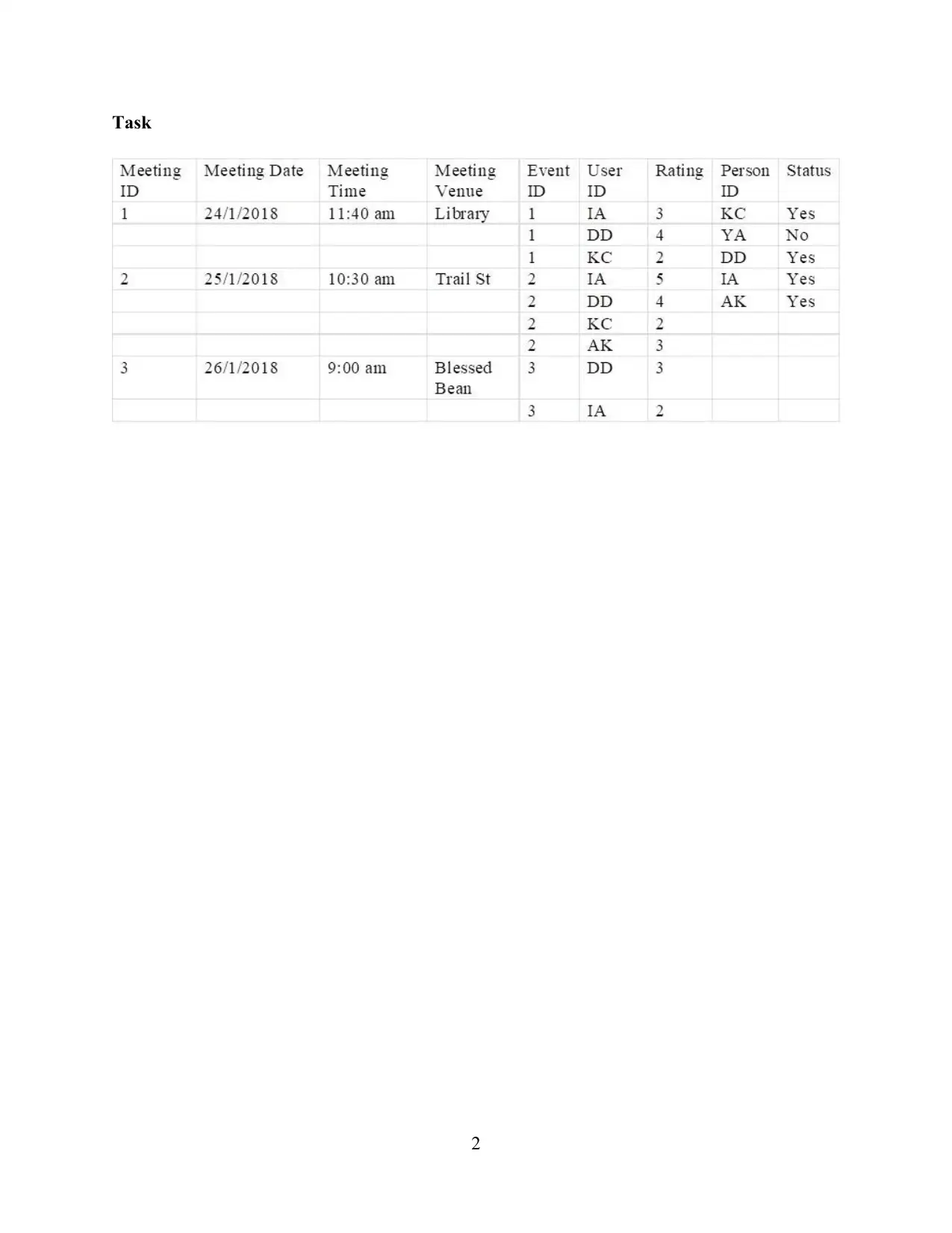
Task
2
2
⊘ This is a preview!⊘
Do you want full access?
Subscribe today to unlock all pages.

Trusted by 1+ million students worldwide
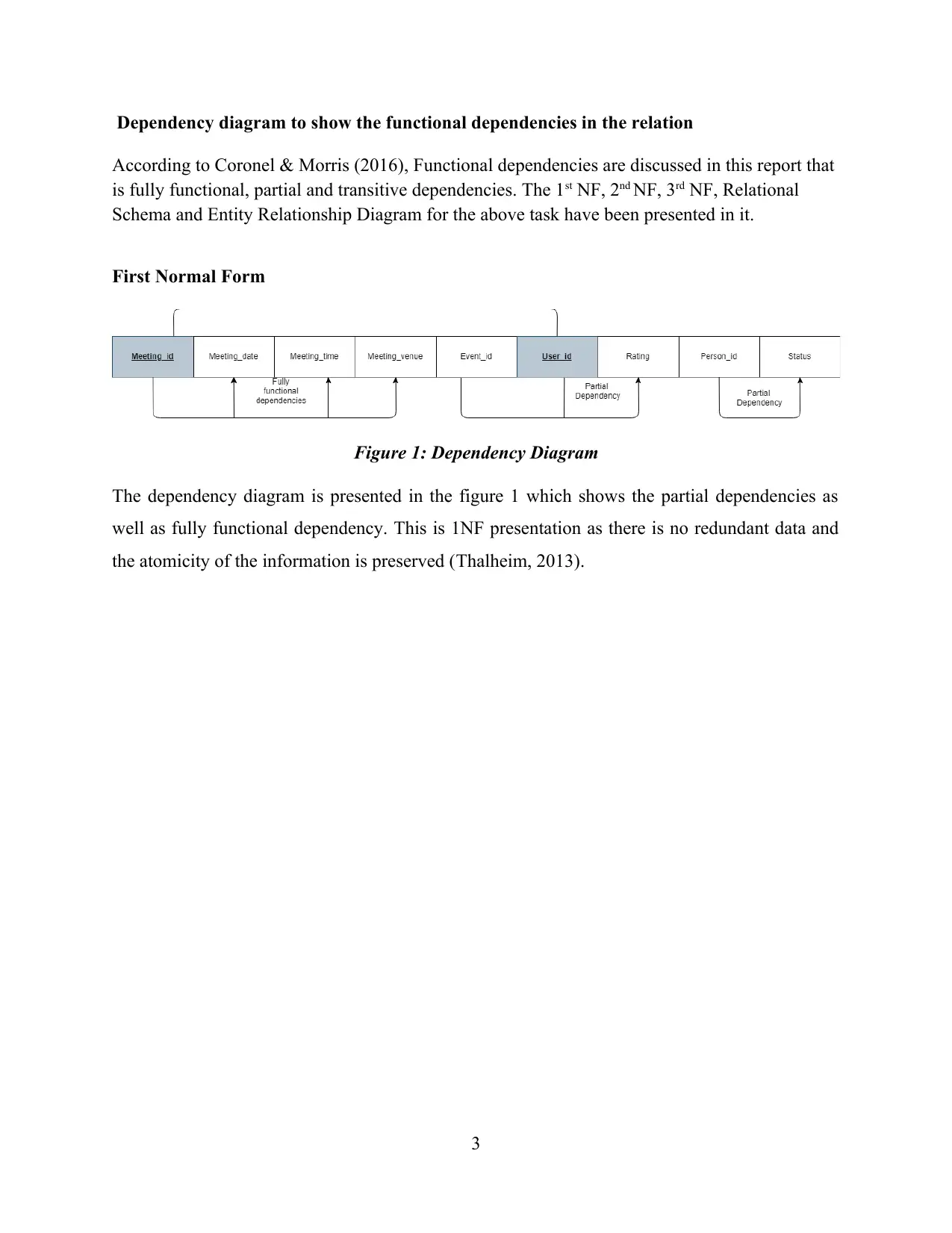
Dependency diagram to show the functional dependencies in the relation
According to Coronel & Morris (2016), Functional dependencies are discussed in this report that
is fully functional, partial and transitive dependencies. The 1st NF, 2nd NF, 3rd NF, Relational
Schema and Entity Relationship Diagram for the above task have been presented in it.
First Normal Form
Figure 1: Dependency Diagram
The dependency diagram is presented in the figure 1 which shows the partial dependencies as
well as fully functional dependency. This is 1NF presentation as there is no redundant data and
the atomicity of the information is preserved (Thalheim, 2013).
3
According to Coronel & Morris (2016), Functional dependencies are discussed in this report that
is fully functional, partial and transitive dependencies. The 1st NF, 2nd NF, 3rd NF, Relational
Schema and Entity Relationship Diagram for the above task have been presented in it.
First Normal Form
Figure 1: Dependency Diagram
The dependency diagram is presented in the figure 1 which shows the partial dependencies as
well as fully functional dependency. This is 1NF presentation as there is no redundant data and
the atomicity of the information is preserved (Thalheim, 2013).
3
Paraphrase This Document
Need a fresh take? Get an instant paraphrase of this document with our AI Paraphraser
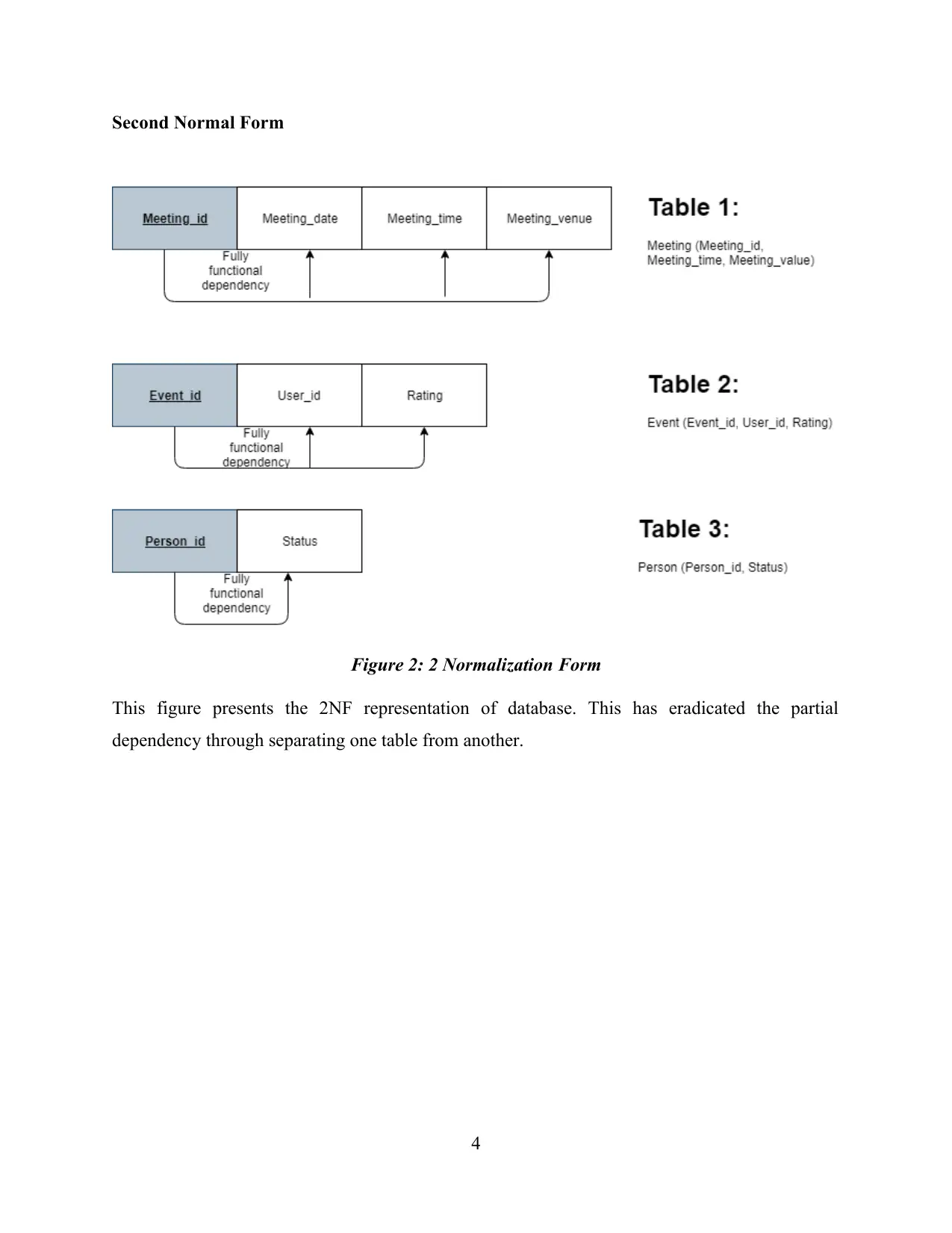
Second Normal Form
Figure 2: 2 Normalization Form
This figure presents the 2NF representation of database. This has eradicated the partial
dependency through separating one table from another.
4
Figure 2: 2 Normalization Form
This figure presents the 2NF representation of database. This has eradicated the partial
dependency through separating one table from another.
4
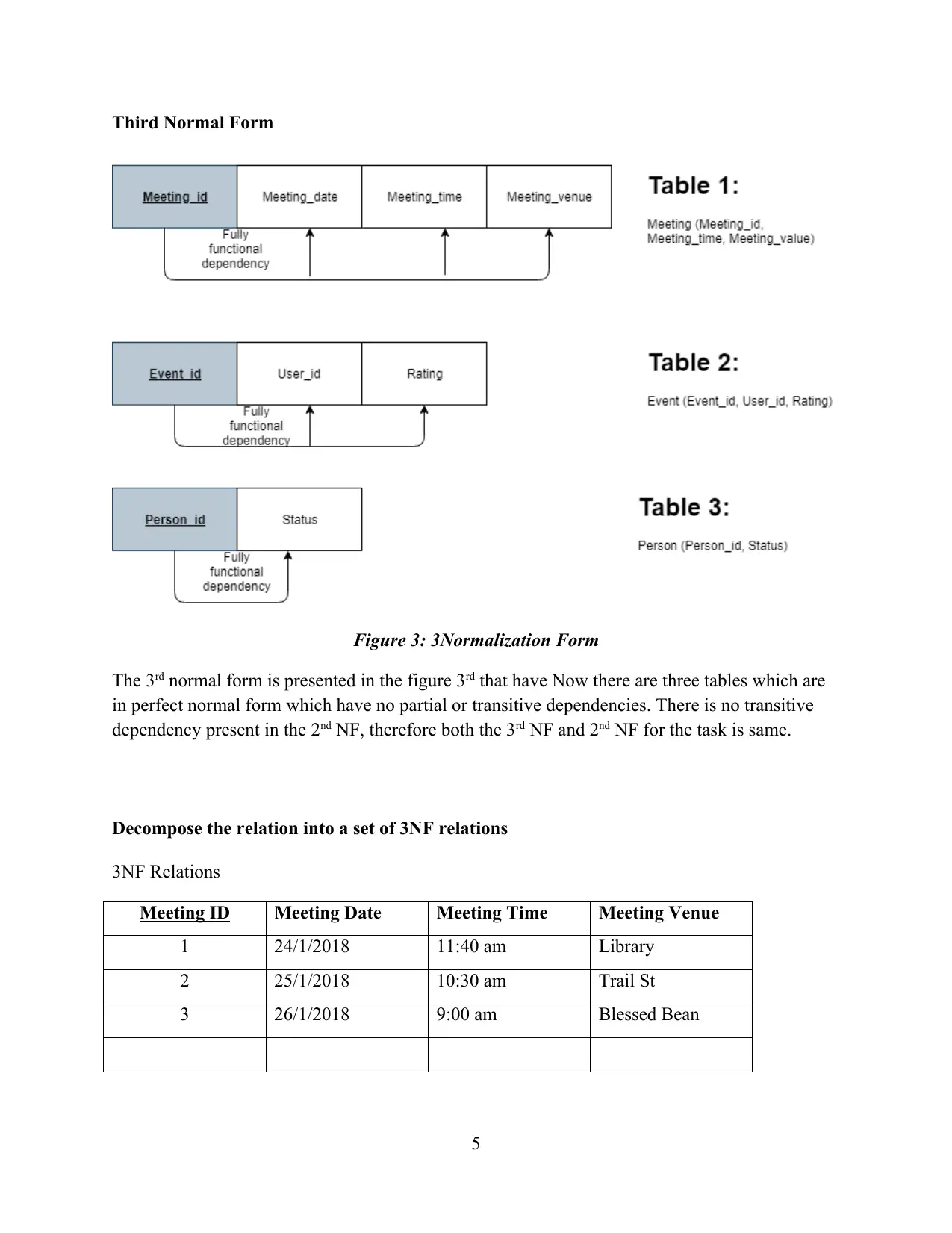
Third Normal Form
Figure 3: 3Normalization Form
The 3rd normal form is presented in the figure 3rd that have Now there are three tables which are
in perfect normal form which have no partial or transitive dependencies. There is no transitive
dependency present in the 2nd NF, therefore both the 3rd NF and 2nd NF for the task is same.
Decompose the relation into a set of 3NF relations
3NF Relations
Meeting ID Meeting Date Meeting Time Meeting Venue
1 24/1/2018 11:40 am Library
2 25/1/2018 10:30 am Trail St
3 26/1/2018 9:00 am Blessed Bean
5
Figure 3: 3Normalization Form
The 3rd normal form is presented in the figure 3rd that have Now there are three tables which are
in perfect normal form which have no partial or transitive dependencies. There is no transitive
dependency present in the 2nd NF, therefore both the 3rd NF and 2nd NF for the task is same.
Decompose the relation into a set of 3NF relations
3NF Relations
Meeting ID Meeting Date Meeting Time Meeting Venue
1 24/1/2018 11:40 am Library
2 25/1/2018 10:30 am Trail St
3 26/1/2018 9:00 am Blessed Bean
5
⊘ This is a preview!⊘
Do you want full access?
Subscribe today to unlock all pages.

Trusted by 1+ million students worldwide

Person ID Status
KC Yes
YA No
DD Yes
IA Yes
AK Yes
Event ID User ID Rating
1 IA 3
1 DD 4
1 KC 2
2 IA 5
2 DD 4
2 KC 2
3 AK 3
3 DD 3
3 IA 2
6
KC Yes
YA No
DD Yes
IA Yes
AK Yes
Event ID User ID Rating
1 IA 3
1 DD 4
1 KC 2
2 IA 5
2 DD 4
2 KC 2
3 AK 3
3 DD 3
3 IA 2
6
Paraphrase This Document
Need a fresh take? Get an instant paraphrase of this document with our AI Paraphraser
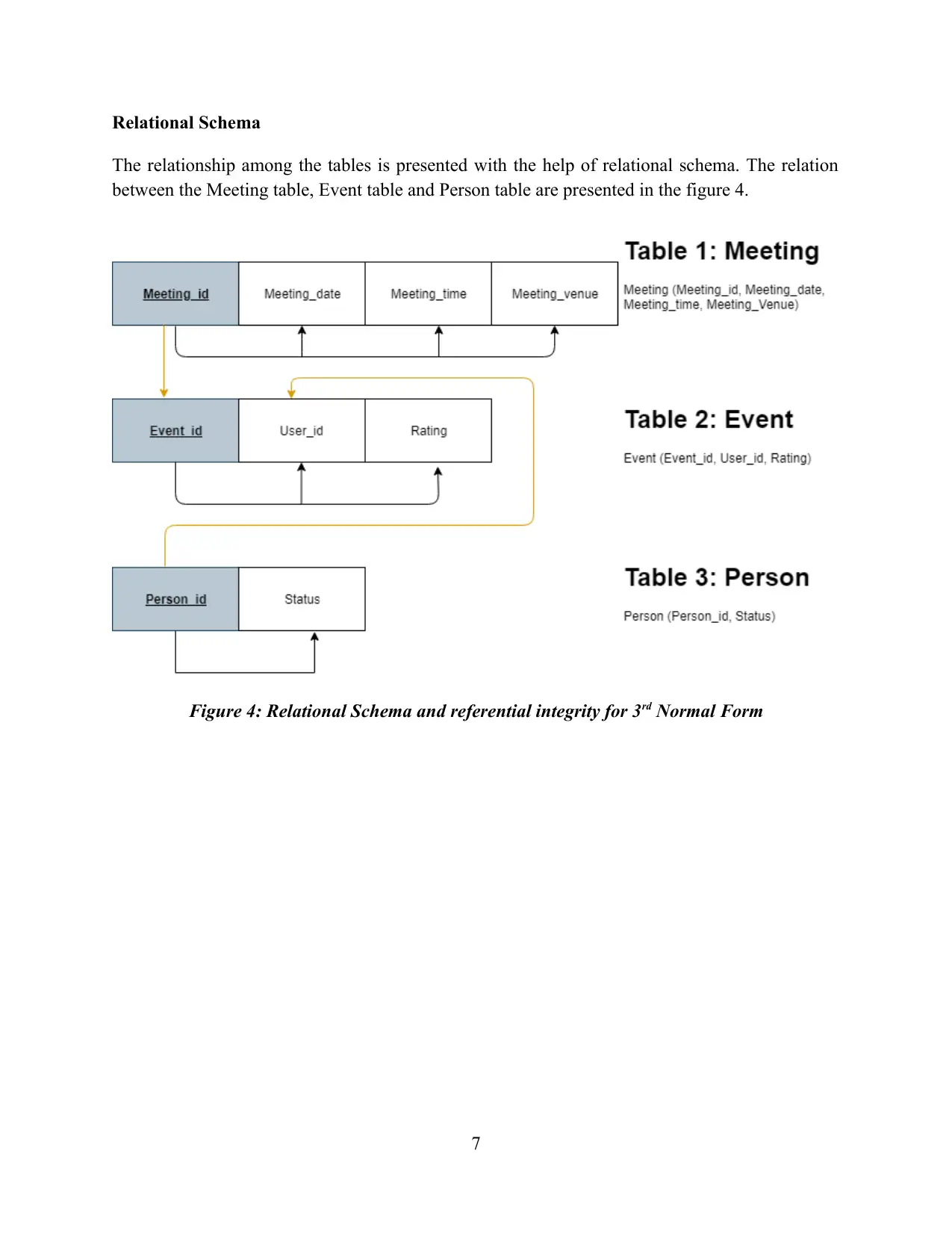
Relational Schema
The relationship among the tables is presented with the help of relational schema. The relation
between the Meeting table, Event table and Person table are presented in the figure 4.
Figure 4: Relational Schema and referential integrity for 3rd Normal Form
7
The relationship among the tables is presented with the help of relational schema. The relation
between the Meeting table, Event table and Person table are presented in the figure 4.
Figure 4: Relational Schema and referential integrity for 3rd Normal Form
7
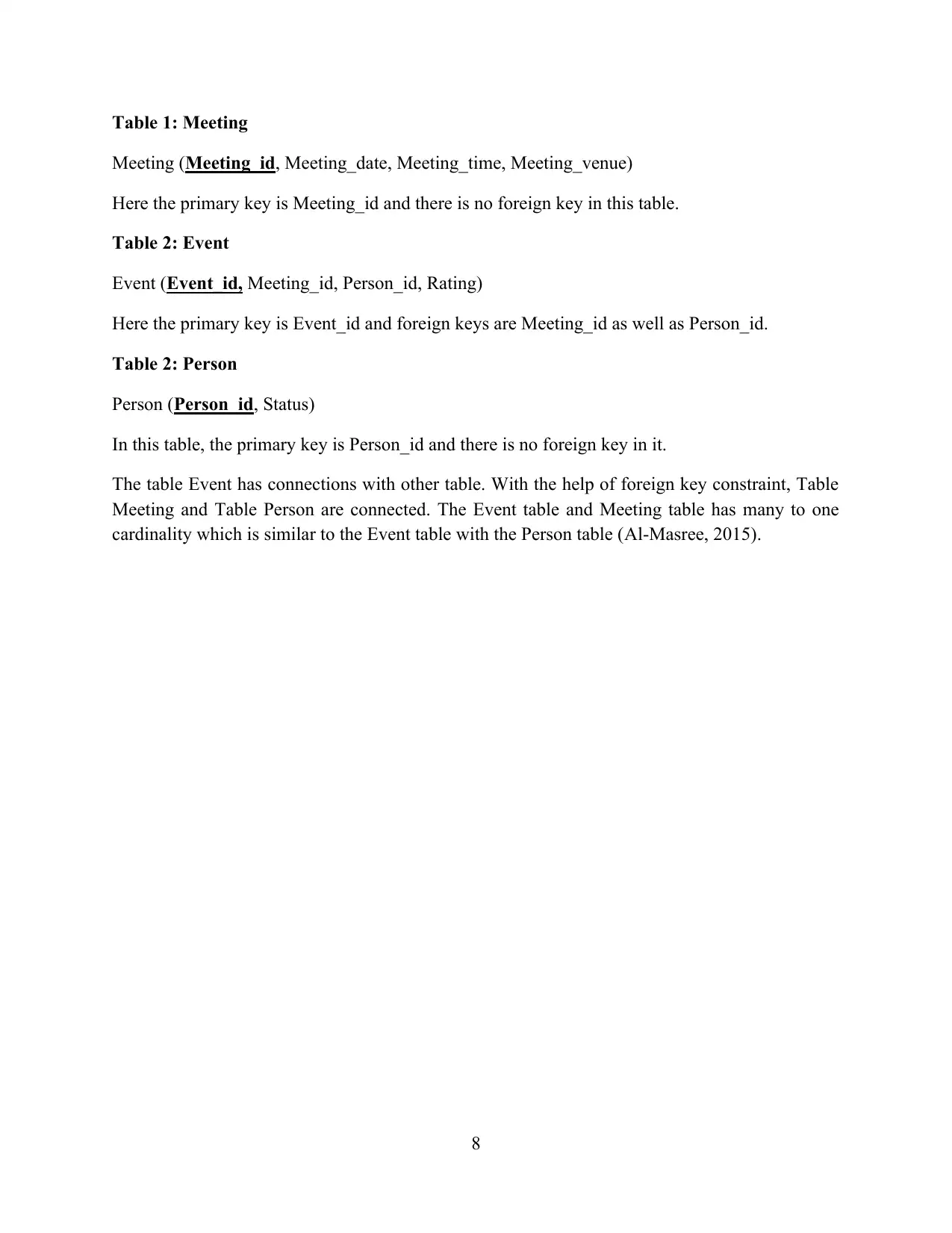
Table 1: Meeting
Meeting (Meeting_id, Meeting_date, Meeting_time, Meeting_venue)
Here the primary key is Meeting_id and there is no foreign key in this table.
Table 2: Event
Event (Event_id, Meeting_id, Person_id, Rating)
Here the primary key is Event_id and foreign keys are Meeting_id as well as Person_id.
Table 2: Person
Person (Person_id, Status)
In this table, the primary key is Person_id and there is no foreign key in it.
The table Event has connections with other table. With the help of foreign key constraint, Table
Meeting and Table Person are connected. The Event table and Meeting table has many to one
cardinality which is similar to the Event table with the Person table (Al-Masree, 2015).
8
Meeting (Meeting_id, Meeting_date, Meeting_time, Meeting_venue)
Here the primary key is Meeting_id and there is no foreign key in this table.
Table 2: Event
Event (Event_id, Meeting_id, Person_id, Rating)
Here the primary key is Event_id and foreign keys are Meeting_id as well as Person_id.
Table 2: Person
Person (Person_id, Status)
In this table, the primary key is Person_id and there is no foreign key in it.
The table Event has connections with other table. With the help of foreign key constraint, Table
Meeting and Table Person are connected. The Event table and Meeting table has many to one
cardinality which is similar to the Event table with the Person table (Al-Masree, 2015).
8
⊘ This is a preview!⊘
Do you want full access?
Subscribe today to unlock all pages.

Trusted by 1+ million students worldwide
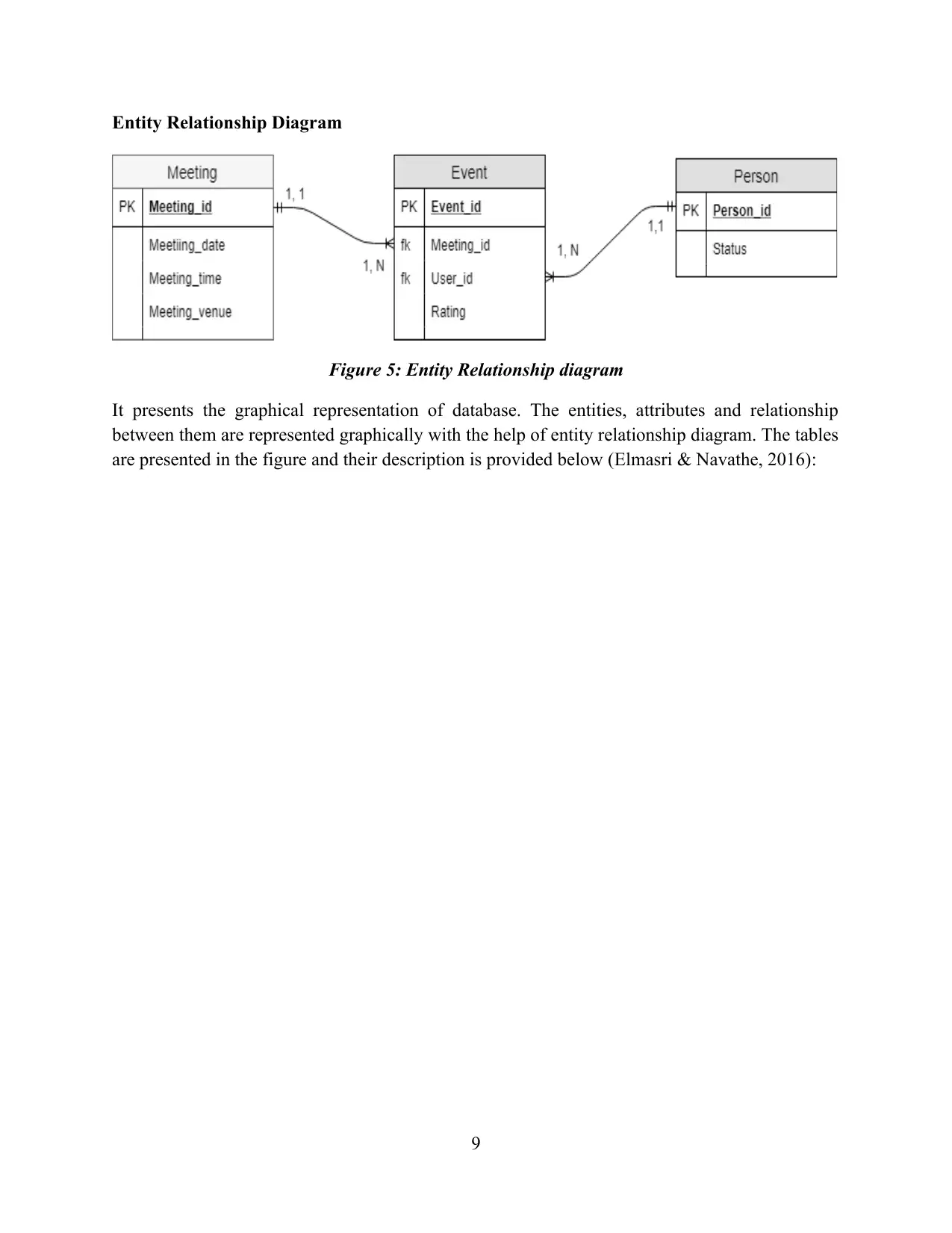
Entity Relationship Diagram
Figure 5: Entity Relationship diagram
It presents the graphical representation of database. The entities, attributes and relationship
between them are represented graphically with the help of entity relationship diagram. The tables
are presented in the figure and their description is provided below (Elmasri & Navathe, 2016):
9
Figure 5: Entity Relationship diagram
It presents the graphical representation of database. The entities, attributes and relationship
between them are represented graphically with the help of entity relationship diagram. The tables
are presented in the figure and their description is provided below (Elmasri & Navathe, 2016):
9
Paraphrase This Document
Need a fresh take? Get an instant paraphrase of this document with our AI Paraphraser
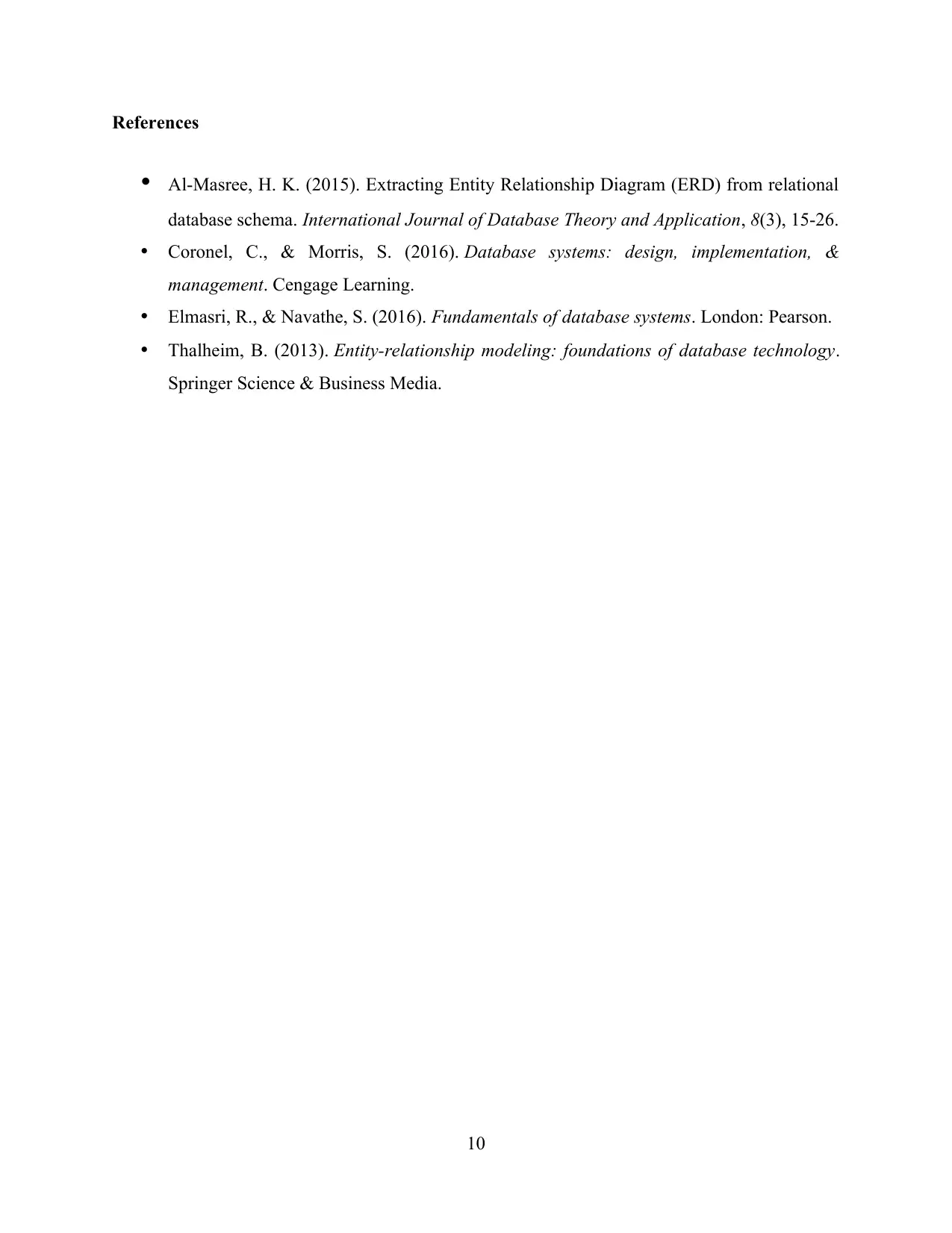
References
Al-Masree, H. K. (2015). Extracting Entity Relationship Diagram (ERD) from relational
database schema. International Journal of Database Theory and Application, 8(3), 15-26.
Coronel, C., & Morris, S. (2016). Database systems: design, implementation, &
management. Cengage Learning.
Elmasri, R., & Navathe, S. (2016). Fundamentals of database systems. London: Pearson.
Thalheim, B. (2013). Entity-relationship modeling: foundations of database technology.
Springer Science & Business Media.
10
Al-Masree, H. K. (2015). Extracting Entity Relationship Diagram (ERD) from relational
database schema. International Journal of Database Theory and Application, 8(3), 15-26.
Coronel, C., & Morris, S. (2016). Database systems: design, implementation, &
management. Cengage Learning.
Elmasri, R., & Navathe, S. (2016). Fundamentals of database systems. London: Pearson.
Thalheim, B. (2013). Entity-relationship modeling: foundations of database technology.
Springer Science & Business Media.
10
1 out of 11
Related Documents
Your All-in-One AI-Powered Toolkit for Academic Success.
+13062052269
info@desklib.com
Available 24*7 on WhatsApp / Email
![[object Object]](/_next/static/media/star-bottom.7253800d.svg)
Unlock your academic potential
Copyright © 2020–2025 A2Z Services. All Rights Reserved. Developed and managed by ZUCOL.


